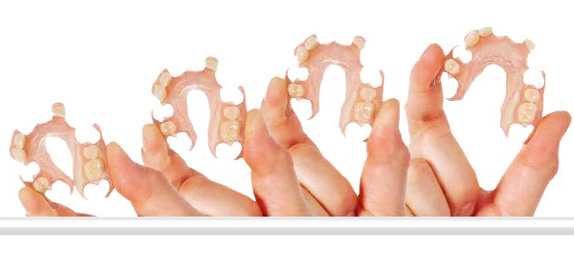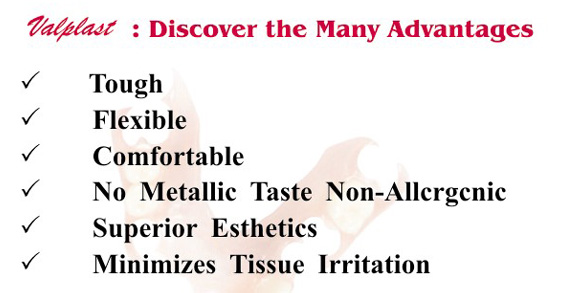|


Valplast is a flexible denture base resin
that is ideal for partial dentures and
unilateral restorations. The resin is a
biocompatible nylon thermoplastic with
unique physical and aesthetic properties.
It allows your patient's natural tissue tone
to appear through the material, matching the
basic shade categories (medium, light pink,
and meharry). Patient's report that it
feels more comfortable because of the
thinness and light weight. It is also
guaranteed for life against breakage when
fabricated and handled according to the
manufacturer's specified procedures.
Special Applications of Valplast
Valplast can be effectively used in the
following special applications:
|
|
|
|
|
|
|
|
|
|
|
|
-
Solves many difficult treatment
problems involving periodontally
involved teeth, sensitive teeth,
cancerous mouths, or other
conditions in which the teeth are
compromised, or comfort is
problematic.
|
|
Valplast Preparation Techniques
Valplast uses the Retento-Grip
tissue-bearing technique for retention. No
tooth or tissue preparation is needed. The
dental laboratory requires only a model
poured promptly and carefully from an
alginate impression and a counter-model. a
custom tray is normally not necessary. A
custom bite and try-in should be taken for
accuracy in free-end saddle cases. The
laboratory can usually complete a unilateral
restoration directly from the first model
with the shade and correct bite.
Insertion Techniques for Valplast
After unpacking the case, and immediately
prior to insertion in the patient's mouth,
immerse the case in very hot tap water.
Leave the case in the water for about one
minutes. Remove and allow it to cool just
to the point where it will be tolerated by
the patients. Gently insert the partial in
patient's mouth.
The hot water treatment permits a very
smooth initial insertion and a good
adaptation with the natural tissues in the
mouth. If the patient senses any
discomfort because of the tightness of a
clasp, the clasp may be loosened slightly by
immersing that area of the partial in hot
water and bending the clasp outward. If a
clasp requires tightening, the clasp area
may be immerse in hot water and bent inward
to tighten.
If any reduction is needed due to persistent
irritation, the resin must be handled
differently than acrylic. It is essential
to use a fairly course grinding wheel or a
parallel cut steel bur (vulcanite bur) for
overall reduction. The resin will melt if
there is prolonged contact with a bur or
wheel, therefore it is essential to move the
instrument over the surface continuously.
Minor relief can be made with a rubber wheel
or a vulcanite bur.
If there are any threads remaining, these
can be removed with a sharp blade. Any
roughness on the surface can be smoothed
with a brown rubber wheel.
The surface may be repolished after
rubberizing (if needed) using coarse pumice,
brown tripoli, and the Val-Shine polishing
compound.
The grinding tools, Valplast knife, and
polishing agents can all be obtained
directly from Valplast International Corp.
Recommendations for Patient Care
Like any removable prosthesis, the patient
should be instructed to practice good oral
hygiene to maintain the appearance and
cleanliness of the Valplast restoration.
The prosthesis should be soaked overnight at
least three nights a week in a good denture
cleaner. Or, the patient may immerse the
prosthesis in a strong denture cleaner daily
for about 10 - 15 minutes. It should be
rinsed and brushed before reinserting in the
mouth.
For additional information on Valplast,
contact our Dental Laboratory or visit
Valplast's website at
http://www.valplast.com/.
|